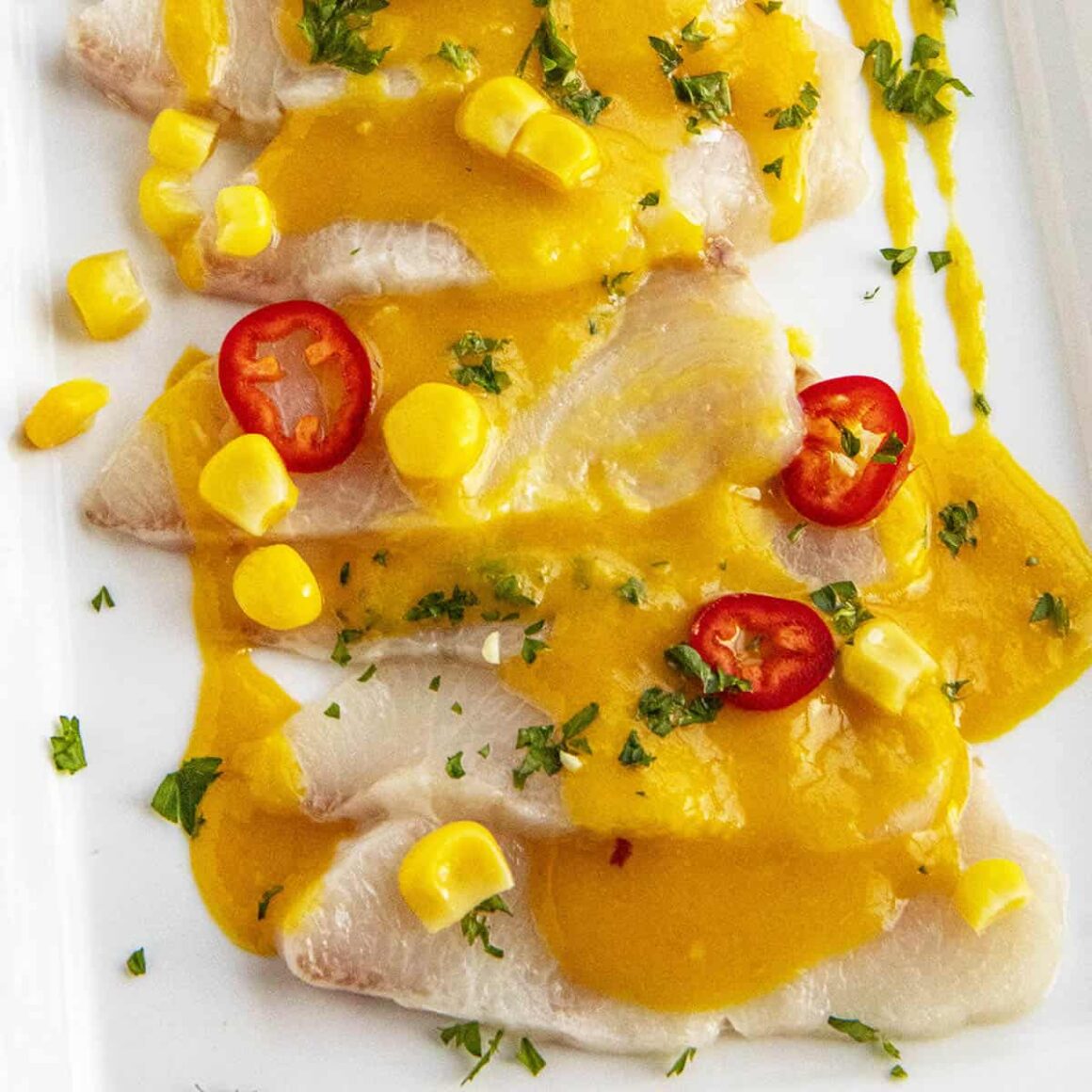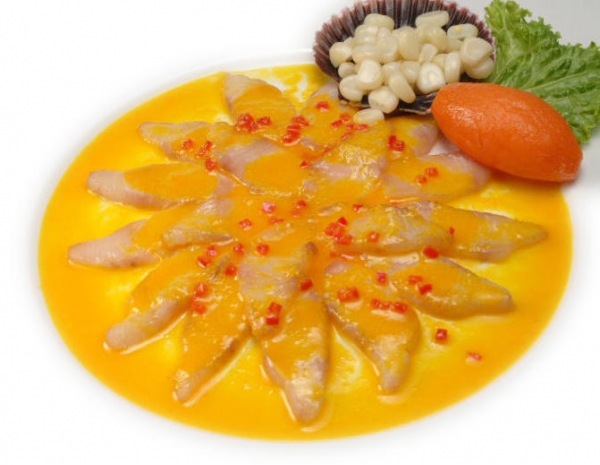Tiradito — Are you ready to embark on a culinary journey that fuses the vibrant flavors of Peru with the delicate artistry of Japan? Look no further than the tantalizing world of Tiradito! This mouthwatering dish is a true testament to the creativity and ingenuity of Pilar Hernandez, a renowned chef who has mastered the art of crafting Tiradito dishes that will leave you craving for more. In this blog post, we will take you through the step-by-step process of preparing a classic Tiradito dish, share an exclusive recipe by Pilar Hernandez herself, and even invite you to join us on a cookbook journey that explores the endless possibilities of Tiradito. Get ready to tantalize your taste buds and dive into a world of culinary fusion like never before!
The Art of Crafting Tiradito: A Culinary Fusion of Peru and Japan

Tiradito
Understanding Tiradito: A Cultural and Culinary Delight
Tiradito, a dish that whispers the history of Peru while echoing the culinary influences of Japan, is a testament to the blend of cultures known as Nikkei cuisine. This exquisite dish, popular in Chile and revered for its simplicity and elegance, is a close relative of sashimi but infused with vibrant Latin flavors. As a raw fish delicacy, tiradito demands not only freshness but also a meticulous approach to its preparation, including the imperative that the fish must be previously frozen to eliminate parasites, ensuring a safe and delightful gastronomic experience.
Read more: Chilean Pastel de Papas Shepherd’s Pie: the Ultimate Comfort Food
Comparing Tiradito and Ceviche: Siblings with Distinct Personalities
While both tiradito and ceviche are iconic in the world of Peruvian raw fish dishes, they present distinct characteristics. Ceviche, the more globally recognized sibling, involves cubed fish that marinates in citrus juices for several hours, allowing the flavors to deeply penetrate the fish. Tiradito, on the other hand, presents the fish in thin, elegant slices which are lightly dressed, allowing the natural taste of the fish to stand in harmonious contrast with the zestful dressing.
The Nikkei Influence: A Culinary Marriage of Peru and Japan
Nikkei food represents a cuisine that has blossomed from the union of Peruvian traditions with Japanese techniques and flavors. This fusion is a direct result of the Japanese diaspora settling in Peru and melding their own culinary heritage with the indigenous ingredients and recipes of Peru. Tiradito is a delightful offspring of this marriage, offering a dish that is both traditional and innovative, with flavors that are distinctly Nikkei.
Tiradito: A Journey of Flavors in Every Slice
This appetizer might seem humble at first glance, but each slice of tiradito is a journey through the diverse landscape of Peruvian and Japanese flavors. The delicate raw fish, with its subtle taste, becomes a canvas for the bold, piquant sauces and garnishes that dress it. The result is a dish that is not just eaten but experienced.
Preparing a Classic Tiradito Dish: A Step-by-Step Guide

Tiradito
Gathering the Ingredients: A Prelude to Flavor
The journey to an authentic tiradito begins with the selection of ingredients. The protagonists of this culinary narrative are the freshest fish available, which will be sliced to perfection, and an array of spices and seasonings that will elevate the dish to its quintessential Nikkei essence.
The Ritual of Slicing: Honoring Technique and Tradition
The preparation of tiradito is as much a ritual as it is a recipe. Slicing the fish demands a level of reverence and skill akin to that of a Japanese itamae (sushi chef). Each slice should be executed with precision, bearing in mind that the elegance of the dish is as much in its presentation as in its taste.
Dressing the Tiradito: The Moment of Transformation
The act of dressing the tiradito is the moment where transformation occurs, where the rich, zesty flavors of the dressing meet the understated elegance of the fish. This is when the tiradito truly becomes a dish that is greater than the sum of its parts, with each component playing its role to perfection.
Check out: Unveiling the Secrets of Chilean Canapés: How to Master the Art of Crafting these Culinary Delights
Tiradito: A Recipe by Pilar Hernandez
Pilar Hernandez, the author of this tiradito recipe, brings a wealth of culinary expertise and a passion for Chilean and Latin American cuisine. Not only has she crafted this recipe with care, but she has also authored a cookbook featuring 75 Chilean recipes for all seasons, making exotic dishes accessible with easy-to-follow recipes tailored to American ingredients and grocery stores. Her work is a bridge between cultures, inviting readers to explore the rich tapestry of Latin American flavors from the comfort of their own kitchens.
The Origin of This Recipe
This specific tiradito recipe is the result of a compensated campaign in collaboration with Kikkoman® and Latina Bloggers Connect. Despite the commercial partnership, Pilar’s creativity and culinary voice remain untainted, with the recipe and all opinions being authentically her own and not edited by others. The recipe is a genuine expression of her love for traditional nikkei flavors, presented for modern home cooks.
Cooking with Confidence: The Recipe for Tiradito
For those ready to embark on the journey of creating tiradito at home, Pilar Hernandez’s recipe is a beacon. The total time required to bring this dish to life is a mere 20 minutes, making it an ideal choice for a sophisticated yet quick appetizer. Designed to yield 4 servings, this recipe is perfect for an intimate gathering where the flavors of Peru and Japan can be savored and celebrated.
Food Safety: Preparing Tiradito Responsibly
As with all raw fish dishes, safety is paramount. It is essential to use fish that has been properly frozen to kill any potential parasites. This crucial step ensures that the tiradito not only tastes exceptional but is also safe for consumption.
Recipe Walkthrough: Crafting Your Own Tiradito
The process of making tiradito is a dance between respecting the raw method used in its preparation and the careful application of seasonings that define its unique taste. The cuisine of tiradito is unmistakably Peruvian, but within its folds, one can detect the whispers of Japanese influence that make it a true Nikkei dish.
Serving and Presentation: The Final Touch
The presentation of tiradito is as important as its preparation. Serve this dish on a flat plate or a wooden board, allowing the colors and textures to draw the eye before the flavors enchant the palate. Garnish thoughtfully, and watch as your guests delight in the harmony of simplicity and complexity that is tiradito.
Exploring Further: A Cookbook Journey with Pilar Hernandez
Pilar Hernandez’s Cookbook: A Treasure Trove of Chilean Cuisine
For those who find themselves enamored with the flavors of tiradito and eager to delve deeper into Chilean and Latin American cuisine, Pilar Hernandez’s cookbook is a veritable treasure trove. With recipes that are both authentic and adaptable, the cookbook is an invitation to explore the richness of these culinary traditions, all while ensuring that the ingredients are accessible to the American home cook.
Pilar’s approach to cooking is rooted in the belief that great food should be accessible to all. Her recipes are designed with this philosophy in mind, ensuring that even those who are new to Chilean or Latin American cuisine can approach the dishes with confidence and ease.
Affiliate Links: Supporting the Journey
As readers embark on their culinary journey with Pilar’s recipes, they may find themselves in need of specific ingredients or cookware. The article contains Amazon affiliate links that provide a convenient way to acquire what’s needed while also supporting Pilar’s work, allowing her to continue sharing her passion and knowledge with the world.
Read more: Pollo con Champiñones: the Ultimate Comfort Food
Joining the Culinary Conversation: Sharing Your Tiradito Experiences
Once you’ve tried your hand at tiradito, the conversation doesn’t have to end. Sharing experiences, tips, and personal twists on the recipe can help create a community of food enthusiasts who appreciate the art of cooking and the joy of exploring new flavors. Whether it’s through social media, blog comments, or personal interactions, every shared experience enriches the global tapestry of culinary exchange.
Conclusion: The Endless Possibilities of Tiradito
Tiradito, with its elegant slices of raw fish dressed in a symphony of Latin and Japanese flavors, is more than just an appetizer; it’s a conversation starter, a bridge between cultures, and a testament to the beauty of culinary fusion. With Pilar Hernandez as your guide, this dish becomes an entry point into a world where tradition meets innovation, and where every bite tells a story. As you explore the vast landscape of flavors that tiradito offers, remember that this is just the beginning of a delicious journey through the art of Nikkei cuisine.
FAQ & Common Questions
Q: What is tiradito?
A: Tiradito is a Peruvian dish that is similar to sashimi but with Latin flavors. It consists of thinly sliced raw fish.
Q: How is tiradito different from ceviche?
A: While both tiradito and ceviche are raw fish dishes, there are a few key differences. In tiradito, the fish is thinly sliced, whereas in ceviche, the fish is cubed. Additionally, tiradito is typically served with a spicy sauce, while ceviche is marinated in citrus juices.
Q: How should I safely consume raw fish in tiradito?
A: To safely consume raw fish in tiradito, it is important to use previously frozen fish. Freezing the fish kills any parasites that may be present. When purchasing raw fish, ask for sushi-grade fish at supermarkets.
Q: Is tiradito a popular dish in Peru?
A: Yes, tiradito is a popular dish in Peru, known for its abundance of seafood. It is also gaining popularity in other countries, including Chile.
Q: Can you recommend any other Peruvian dishes?
A: Yes, if you enjoyed tiradito, you may also enjoy trying other Peruvian dishes such as ceviche, lomo saltado, or causa.




